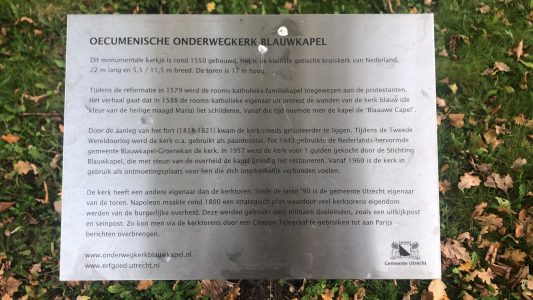This monumental church was built around 1550. It is the smallest Gothic cruciform church in the Netherlands, 22 m long and 5.5 / 11.5 m wide. The tower is 17m high.
During the Reformation in 1579, the Roman Catholic family chapel was assigned to the Protestants. The story goes that in 1588 the Roman Catholic owner had the walls of the church painted blue (the color of the Virgin Mary), in order to sign protest. From that time on, the chapel was called the ‘Blaauwe Capel'.
Due to the construction of the fortress (1818-1821), the church became increasingly isolated. During the Second World War, the church was used as stables for horses. Until 1943, the Dutch Reformed community of Blauwkapel-Groenekan used the church. In 1957 the church was bought for 1 guilder by the Blauwkapel Foundation, which had the chapel thoroughly restored with government support. Since 1960, the church has been used as a meeting place for those who feel interdenominational.
The church has a different owner than the church tower. The municipality of Utrecht has owned the tower since the 1990s. Around 1800, Napoleon made a strategic plan whereby many church towers became the property of the civil government. These were used for military purposes, such as a lookout and signal post. For example, messages could be transmitted to Paris via the church towers by using a Chappe Telegraaf.
NB
Ecumenical = secular unity of religion

